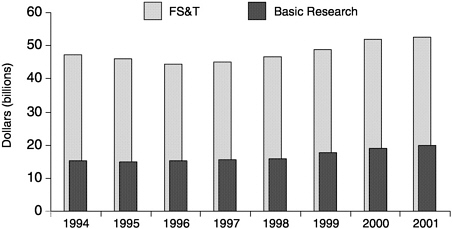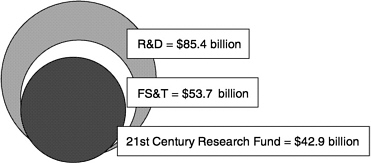Observations on the President's FY 2001 Federal Science and Technology Budget
FINDINGS
-
The Administration's FY2001 budget proposes a Federal Science & Technology (FS&T) increase of 1.3 percent in constant dollars. The stated goals of the budget are to ensure the health of the nation's research enterprise through steady and balanced growth, and to capture the public imagination by identifying exciting initiatives in research to improve the health and welfare of the American people.
-
The 21st Century Research Fund is part of the Administration's strategy to emphasize basic research and knowledge-creating investments. The Fund would increase 5.0 percent in constant dollars. The Fund represents an important step toward identifying those investments aimed at knowledge-creation.
-
The budget would sharply increase National Science Foundation (NSF) spending, and would alleviate the disparity in funding growth in the life sciences and other scientific fields. In the committee' s opinion, large budget reductions proposed for Department of Defense (DOD) and some other mission agencies may threaten adverse consequences for certain fields of science and engineering. In particular, uncertain funding jeopardizes recruitment and training of the next generation of researchers.
-
In the committee's judgment, sharp funding increases in biomedical fields may strain the capacity of existing infrastructure and facilities in some universities and other institutions expected to carry out the increased research in those fields. In the context of such increases, the problems of unreimbursed indirect costs need attention through a simplified formula
-
-
that would protect both the interests of research organizations and the government.
-
-
Since 1987, industry R&D has increased 196 percent, and the federal share of total R&D in the U.S. has dropped from 46 percent to 27 percent.
The FY 2001 FS&T budget
The FS&T budget encompasses the federal investment in the creation of new knowledge and technologies, as detailed in earlier reports from the National Academies.1 The Administration has moved toward this concept by identifying, in addition to the usual R&D budget, a budget known as the 21st Century Research Fund, similar in spirit to the FS&T concept but stressing as well its research priorities. We have compared the R&D, FS&T, and Fund budgets in Figure 2 and in Table 1, Table 2, and Table 3. As can be seen in Table 1, FS&T differs from the Fund by about $11 billion, of which $3 billion is the 6.3 budget of DOD, $4 billion is Human Space Flight and Mission Support in NASA, and $2.8 billion is DOE Defense Activities. Both the FS&T budget and the Fund provide visibility for the research budget and its change in the context of the overall R&D budget.

FIGURE 1 FS&T Budget and Basic Research, FY 1994-FY 2001 (budget authority in billions of constant FY 2000 dollars)
|
1 |
Allocating Federal Funds for Science and Technology, Committee on Criteria for Federal Support of Research and Development, NAP 1995; and the annual “Observations . . .” reports from COSEPUP in 1998 and 1999. |

FIGURE 2 FY 2001 R&D, FS&T, and 21st Century Research Fund (in billions)
The FY2001 budget proposes a small increase in FS&T—$674 million, an increase of 1.3 percent from FY 2000 in constant dollars, to a total of $52.6 billion.2 (See Figure 1) Last year, the administration requested an increase of only 0.4 percent in FS&T spending, but the Congress raised it 6.4 percent in appropriations. (see Table 3). Of particular note in FY2001 are the proposed increases at NSF (17.5 percent), HHS (3.9 percent), and certain programs in DOE (5.9% overall). NASA has a real increase (0.7 percent) for the first time in several years. DOD FS&T spending would be cut 13.9 percent. Aside from large proposed increases at NIH and NSF, proposed FS&T spending in the rest of the federal government would be down 1.4 percent.
The administration proposes to spend $42.9 billion on the 21st Century Research Fund, an increase of 5.0 percent in constant dollars over FY 2000. This is substantially higher than the 1.7 percent increase in constant dollars proposed by the administration for this fund in FY 2000, but smaller than the 6.5 percent growth actually appropriated by Congress last year. A set of inter-agency initiatives is highlighted this year, with focused efforts in nanotechnology ($485 million), information technology ($2.27 billion), clean energy ($283 million), climate change ($1.4 billion), and six others, as detailed in Table 4. The emergence of the 21st Century Research Fund is a welcome program descriptive device for some areas of research that are ripe for making dramatic progress, and other areas of current importance to society.
|
2 |
The GDP deflator, about 2.2 percent a year for 1994-2000 and 2.0 percent for 2001, is used by both COSEPUP and AAAS in calculating constant-dollar figures. |



